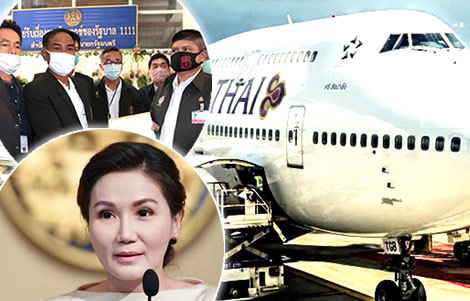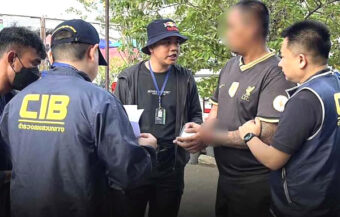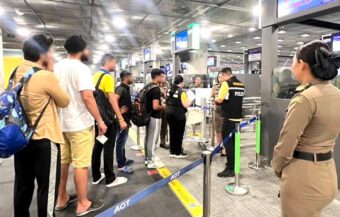As Thai Airways readies itself to file for bankruptcy with mandarins at the Ministry of Transport now firmly in control, many questions remain. Not least, where it will file for bankruptcy and how long will the process take? One Bangkok investment firm, at the end of the week, saw the current move as a high risk one. In the coming days, it is being reported that the Thai premier will handpick a team to lead the bankruptcy process which must, first of all, seek the approval of the courts to produce a viable rehabilitation plan and then get it approved by creditors. The challenge is quite daunting with the real risk of failure if the process runs into unexpected turbulence.
The future of Thai Airways is very much still up in the air, this week, just days after the government’s fateful decision in principle to have it file for bankruptcy protection. Before this, there will be steps to sell off a 3% government stake so that it will lose its status as a state enterprise. It is now accepted that at least 6,000 workers will lose their jobs and it is by no means certain what will emerge from the process despite plans by the airline’s management to keep Thai Airways flying. One of the first things to be clarified is where the firm will file for bankruptcy which is expected to happen sometime in mid-June.

Following the decision by the cabinet on Tuesday to have Thai Airways seek bankruptcy protection comes the question of where the state carrier will apply.
It is understood that Thailand’s Transport Ministry has recommended that the matter be filed with the Thai courts but it has also been suggested that it may be necessary to file for bankruptcy in the United States as over 30% of the firm’s debt is owed to foreign concerns.
It is a key consideration and could have significant implications for the whole process which is expected, in any event, to take some time.
Government spokeswoman said it was not clear yet where Thai Airways will file for bankruptcy
This week, government spokeswoman Narumon Pinyosinwat confided that it was not yet clear where Thai Airways will file for bankruptcy.
However, the decision by the cabinet was made, reportedly, on the understanding that this would be under the 1940 Bankruptcy Law in Thailand which was extensively amended after the 1997 financial crisis and particularly in 2015.
The changes after 1997 very much followed the American legal model as an example.
It is abundantly clear, from the outset, however, that this bankruptcy will require practitioners with extensive international skills.
Share price has risen in Bangkok
The decision taken this week, in the short term, has sparked more confidence among some of the shareholders in the concern.
Thai Airways shares in Bangkok have risen by over 5% in the aftermath of the decision on Tuesday.
Main union has change of heart even as it means its dissolution to allow a new start for Thai Airways
It has now also emerged that the Thai Workers Union which on Monday had sworn to vehemently oppose the decision to reduce the government’s majority stake in the airline has had a change of heart.
The union leader, Nares Puengyam, now accepts that this move is essential to transform the status of Thai Airways and delist it as a state enterprise which otherwise will make any rehabilitation process impossible under Thai legal provisions.
On Wednesday, he said: ‘We opposed this position before but after reexamination, we have to show creditors that Thai Airways will genuinely follow the restructuring plan. Including adjustments to the board and staff.’
Airline to lose its status as a state enterprise as a key requirement towards a rehabilitation plan
The move, which was decided by the cabinet on Tuesday, will see the Vayupak Fund which was set up by the Ministry of Finance, purchase a further 3% in the airline bringing state ownership to 48%.
This will mean that Thai Airways will no longer be a state enterprise.
The price to be paid is expected to be somewhere between ฿600 and ฿700 million.
The effects of this, by law, will mean the dissolution of the worker’s union but union leaders are reportedly considering the establishment of a new representative body for the staff at the airline.
Currently, there are 21,000 people in Thailand employed by the state carrier but nearly all observers expect this to be slashed by at least 6,000 as part of the survival plan which still has to be developed for the airline.
Airbus seeking payments on 30 leased aircraft
Earlier this week, it was reported that the giant European aircraft firm, Airbus, was seeking payment in respect of 30 airliners leased to the national airline.
In recent years, Thai Airways has had a close relationship with Airbus and was thought to be on the verge of partnership with the airline manufacturer in respect of a $340 million aircraft repair facility being proposed at the government’s flagship Eastern Economic Corridor project.
However, Airbus withdrew from the proposed plan at the end of April and this week, we have established that the state-owned Thai Airways of old is to fly no more.
The new Thai Airways, if the bankruptcy rehabilitation plan is successfully launched, will be a privately owned concern operated strictly to commercial realities.
Thai Airways, before it was grounded due to the current coronavirus emergency, had 53 airliners in service with the rest being Boeing aircraft.
Prime Minister to handpick rehabilitation team to drive new Thai Airways takeoff through bankruptcy
On Sunday, the 25th of May, it is being reported that the Thai prime minister will choose from a list of 30 names proposed by the Ministry of Transport to head up its rehabilitation team.
It is expected that sometime in mid-June, Thai Airways will apply for bankruptcy through the Ministry of Transport.
One possibility is that the company may file for protection in both Thailand and the United States to protect the airline from foreign creditors while a rescue plan is being hammered out.
New culture expected with an end to perks
The essence of the rehabilitation plan will be to rid the airline of its traditional culture of providing perks to state officials in Thailand while cutting its workforce to make it more competitive.
The firm is also expected to be freed from political considerations and thinking which is an inevitable feature of any state-owned firm the world over.
Significantly, government officials also felt that the price to the Thai taxpayer in carrying forward Thai Airways as a state enterprise was one that could no longer be justified.
Prime Minister says Thai Airways decision was in the best interests of the general public
Although he did not go into detail, General Prayut referred to this in a Twitter message this week when he said that at this time of catastrophe due to the Covid 19 crisis, the Thai government must conserve public funds to help the people.
‘Today, I made a difficult decision regarding @ThaiAirways. But it’s one that I know is in the best interests of every member of the public and of our country,’ the prime minister disclosed on Twitter.
Government faced a choice between more state loans and a radical shake-up through bankruptcy
The government faced a choice of continuing to provide loans to the ailing firm or opt for this more radical alternative. The rejected plan would have called for ฿50 billion in state funds to be made available.
Government sources, however, pointed out that as Thai Airways has private shareholdings over 31%, any further provision of loans to the firm would have also have violated Thai law including the State Fiscal and Financial Disciplines Act.
Under the approved scheme, ฿200 billion, in Thai Airways debt will have to be first of all frozen until the reorganisation is finalised.
The rehabilitation plan will require the working out of a repayment proposal, on this debt, to the creditors which will require approval by them and the courts.
Plan must be agreed by creditors and approved by the courts before any new future as a private concern
Before the rehabilitation plan can be put into action, the business proposal must be agreed by the creditors and later by the courts involved in the process provided they agree to take it up and grant protection in the first place.
It is anticipated that, in the meantime, Thai Airways will continue to operate with a lower staff count until the plan is finalised.
Of course, this will be a decision for the administrator of the company who will bear ultimate responsibility for the concern to the courts.
Most of the company’s debt is made up of bondholders who account for ฿82 billion of the outstanding money.
Many of these are employee cooperatives in the kingdom, the largest of which is the Electricity Authority of Thailand.
However, this week, the Finance Ministry reported that these cooperatives have assets in excess of ฿3 trillion and can wait until the rehabilitation plan is finalised.
It was also suggested this week that some goodwill exists among creditors of Thai Airways to see the ailing airline undertake and complete a successful rehabilitation process.
Bank debt in Thailand, Germany and the US
The airline also has debt with Thai banks including Krung Thai Bank, CIMB Thai and the Government Savings Bank as well as debt facilities with banks in Germany and the United States.
The company has reported bank debt of over ฿74 billion and further ฿3.4 billion in short term borrowings. It also has an outstanding debt of over ฿46 billion on foot of plane leasing contracts.
One key element of its rehabilitation plan will be the ability of the airline to spin-off key assets or subsidiary businesses.
Thai Airways has a subsidiary budget airline, Thai Smile and a minority stake in Nok Airways, a popular Thai low budget carrier that had grown exponentially prior to last year’s downturn in tourism and this year’s coronavirus emergency.
Speed of bankruptcy reorganisation process will be critical to the success of the plan says ministry source
This week, a source at the Ministry of Finance highlighted the spin-off of subsidiary assets as a critical issue and also the speed at which the overall bankruptcy process can be undertaken and completed.
‘If the rehab process moves fast and some businesses can be split apart, then Thai could recover within a year,’ the source said.
This may be optimistic and once the firm is placed into bankruptcy and the administration of the courts, there are no guarantees as to what will happen next particularly as the process may involve two jurisdictions.
Bangkok investment firm sees Thai Airways bankruptcy rehabilitation plan now as high risk
On Thursday, Tisco Security, a brokerage and investment advice firm in Bangkok was less than confident about the prospects for the regeneration of the iconic airline.
It labelled the bankruptcy rehabilitation operation as a high risk one.
It pointed to 52 prior instances of listed firms seeking bankruptcy protection since the 1997 crisis. It noted that 38% had failed while 44% were successful. It also observed that it takes on average 7 years to complete such a process.
One thing is certain and that is that if Thai Airways emerges from this, it will be a privately owned concern, more streamlined and more competitive.
Whether this is at all possible, we will have to wait and see.
Further reading:
Australian man’s heartbreak cut off from his Thai wife – begs to be included on repatriation flights
Deputy Transport Minister calls talks with Thai Airways, seeks new business plan in 3 months
Microsoft accepts charges of corrupt payments in Thailand as it makes a deal with US investigators
Thailand recession fears as airline losses mount with lower tourist numbers and a strong baht


















